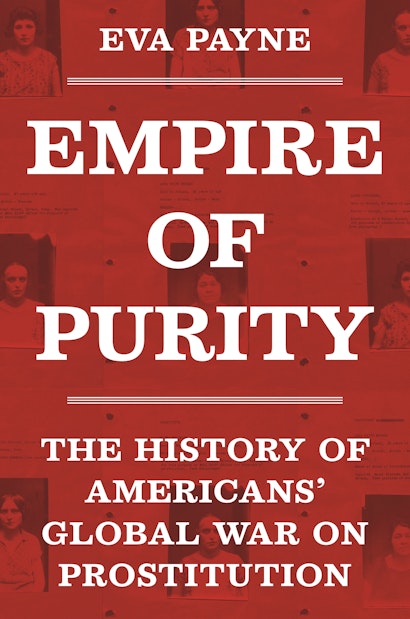Debates over women’s right to bodily autonomy and how the government might best protect women marked the 2024 US presidential race. In September 2024, Donald Trump proclaimed to an audience of women during a rally, “I am your protector.” Under his presidency, he argued, women “will be happy, healthy, confident and free. You will no longer be thinking about abortion,” framing the criminalization of abortion that resulted from the overturn of Roe v. Wade as a means of protecting women. Less than a week before he won the election, he told a crowd that he planned to protect American women “whether the women like it or not.”
With this rhetoric, Trump drew on a deeper history of protective violence against women in American politics. The control of women’s bodies, under the name of protecting women and the nation, has been a crucial part of how US power has operated and expanded on the global stage. Americans’ war on prostitution in the early twentieth century helped to cement this pattern. American activists pushed for laws that prohibited women from profiting from their own sexual labor, increased surveillance of women, and punished them with incarceration. Yet these activists did so under the guise of protecting vulnerable women from sexual exploitation and improving their lives.
In the early 1900s, American reform organizations and the US government fought the “white slave traffic,” their term for forced prostitution. The white slavery narrative portrayed young, primarily white women as innocent victims of dangerous foreign or African American men who tricked them into prostitution. At the same time, it positioned any woman who sold sex – particularly immigrant and African American women – as dangerous to the United States. Yet selling sex was one of the best paying jobs available to these women, who had to weigh the risks of long days in factory or domestic work for little pay, versus those of brothel or street-based sex work, where they could earn more money in far fewer hours.
Economic and social constraints, rather than nefarious traffickers, generally led women to sell sex. Cases of forced prostitution comprised only a small percentage of the commercial sex industry, but the laws passed to combat it expanded state power over women’s bodies without addressing the factors that made women vulnerable to labor exploitation. Domestic anti-trafficking laws such as the 1910 Mann Act, which criminalized transporting a woman across state lines for “immoral” activity, gave the federal government new powers to surveil sex workers and police Black men who had consensual sexual relationships with white women. The 1910 Immigration Act allowed for the deportation of immigrant women who sold sex at any time after their arrival, no matter the length of time they had resided in the United States. These laws, which claimed to rescue trafficked women, punished people who were already marginalized because of their race, immigration status, and class.
Building on these efforts, during WWI the US government initiated an all-out war on prostitution. The military claimed it was keeping soldiers healthy and fit to fight in the war, while also protecting American women from the ills of prostitution, even creating a “Committee on Protective Work for Girls” to rescue young women who might sell sex. Yet US officials arrested and incarcerated over 30,000 women and girls on the US mainland during the war. Men who attempted to purchase sex or who carried a sexually transmitted infection, public health officials argued, were too important to the war effort and thus should not face jail time. Declaring a war on prostitution, the government enacted a war on women, specifically, poor, working class, and African American women, whom police disproportionally targeted.
When US military officials decided to take their anti-prostitution crusade to US colonies in the Caribbean, the results were even more disastrous for women. The US government had overseen licensed prostitution in its overseas colonies since the War of 1898. Under this system, women registered as prostitutes, submitted to regular pelvic examinations for sexually transmitted infections, and underwent compulsory treatment in a prison hospital if found infected. Yet overnight, the US military turned prostitution from a legal form of labor into a crime.
Under the guise of uplifting so-called tropical peoples, particularly those of African descent, US officials incarcerated thousands of women and girls and subjected them to medical experimentation and sterilization. In Puerto Rico, US military doctors used incarcerated women as test subjects for different syphilis treatment regimens, which involved painful injections, douches, and applications of dangerous mercury and arsenic compounds. As the doctors noted, since the women were incarcerated, they could be forced to undergo intensive regimens that other patients would reject. In Colón, one of the terminal cities of the Panama Canal, a US-run hospital performed hysterectomies on women they deemed prostitutes, claiming that by removing any diseased organs, they were also cleansing the women’s minds so that they would pursue “honorable” work. In the Dominican Republic, the occupying US military government passed a law that dramatically expanded the definition of prostitution, making all women subject to surveillance and arrest. Such laws, US officials claimed, allowed to US military to give Dominican women “protection” from their lustful compatriots, and proved the humanitarian nature of the US occupation.
Protection requires a protector, who acts on behalf of those who cannot act for themselves, whether they consent or not. Seen in this light, both early twentieth century attempts to protect prostitutes and Trump’s claims to protect American women – through policies ranging from abortion bans to mass deportations – look more like a bid to control women’s bodies rather than to protect their rights.
Eva Payne is assistant professor of history at the University of Mississippi. Her writing has appeared in publications, such as the Journal of Women’s History and Radical History Review.

